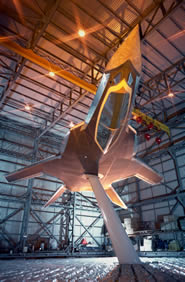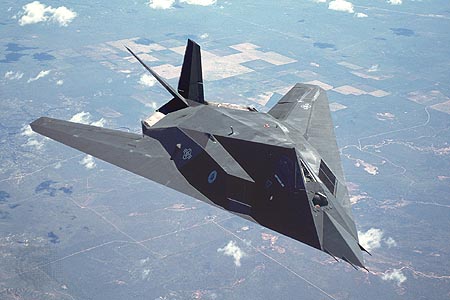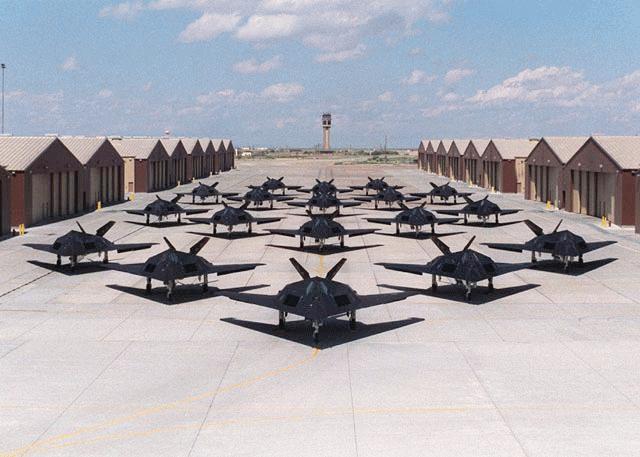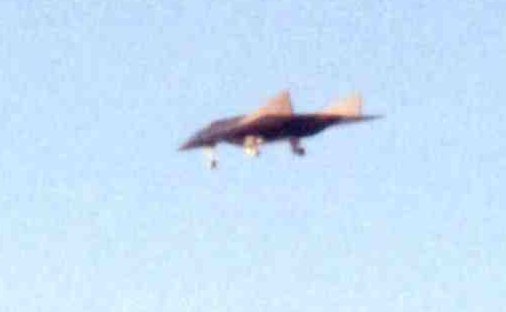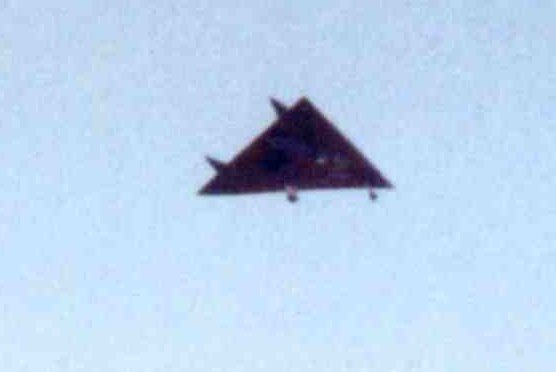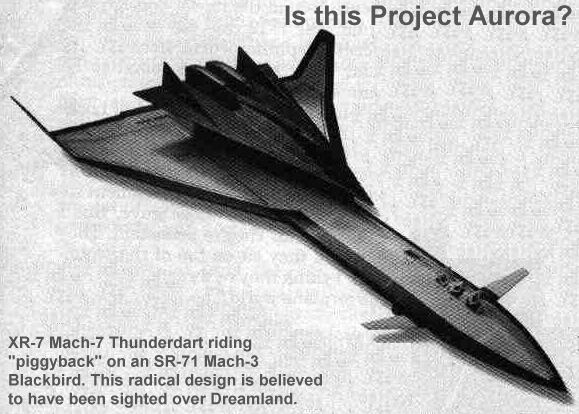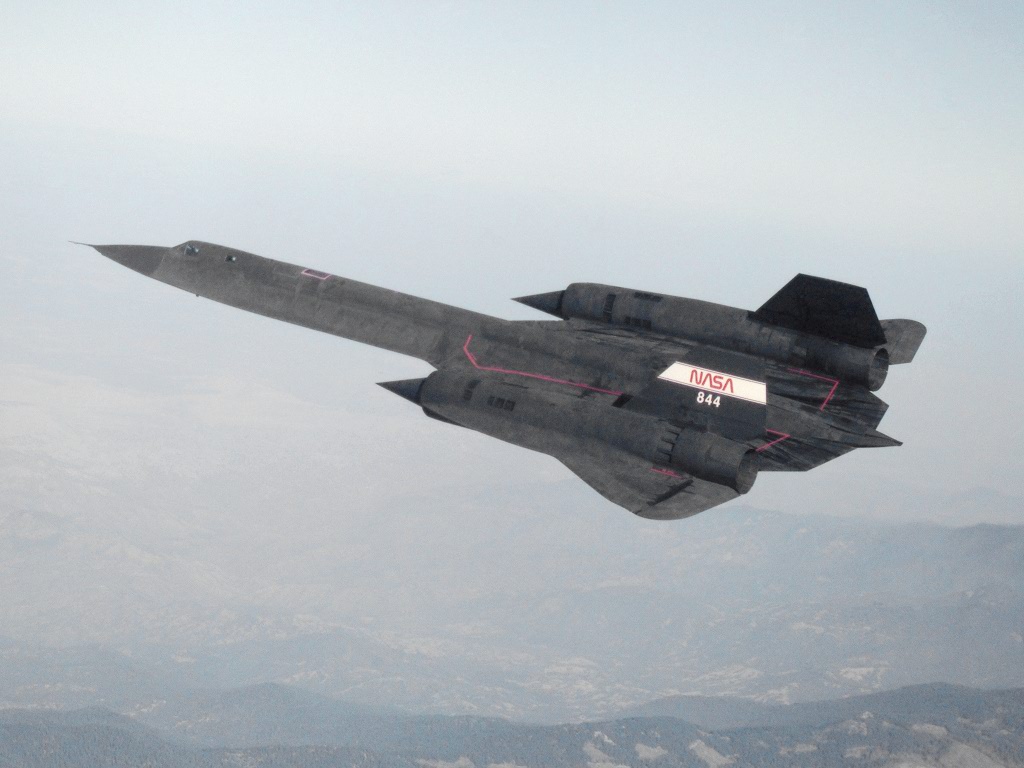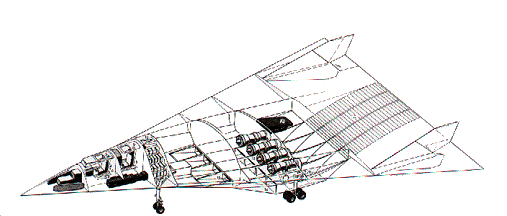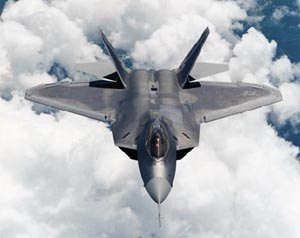| Plasma
-
links to plasma
physics sites.
Couple of things to keep in mind: plasma
is ionized gas particles. Therefore, plasma flow is a flow of ionized
gas particles. Ion is an electrically charged particle or group of
atoms. Plasma cloud is a quasineutral (total electrical charge is zero)
collection of free charged particles. The vast majority of matter in the
universe exists in plasma state. Near the Earth plasma can be found in
the form of solar wind, magnetosphere and ionosphere. The main property
of plasma (for our purposes) is its frequency, which is equal to a
square root of a ratio of 4 * Pi * square of ion charge * concentration
of ions to the mass of ion:
There are several types of oscillations in
plasma: low frequency (ion-sound waves), high frequency (oscillations of
electrons relative to ions), spiral waves (in the presence of a magnetic
field - "magnetosound"), and cross waves propagating along a magnetic
field. A device for generating plasma is called plasmatron.
This device generates the so-called low-temperature plasma. A
brief guide to
plasmas
This is not new:
Russians offer radical stealth device for export
"A Russian
scientific research organisation is to offer for export a 'bolt-on'
stealth device that it claims renders non-stealthy aircraft
practically invisible to radar. The system, which envelops the
aircraft in a cloak of ionised gas known as a plasma, is said to be
fully developed, with work on a "third-generation visibility-reduction
system" under way.
Keldysh NITs
(Nauchno-Issledovatelskiy Tsentr or Scientific Research Centre) is
making the claims. According to its director, Anatoliy Koroteyev, the
system weighs less than 100kg and consumes little more than several
dozen kW of power.
Given the
state of the Russian economy, analysts consider it unlikely that any
of NITs' work has been applied to Russian Air Force aircraft.
According to Koroteyev, however, the system will soon be offered for
export.
By installing
the system, a typical aircraft radar cross-section (RCS) might be cut
"by more than 100 times", Keldysh NITs officials said. This would be
much the same RCS as dedicated US stealth aircraft such as the
Lockheed Martin F-117 stealth fighter and the Northrop Grumman B-2
stealth bomber.
The claims
are given credence by corroborating information on the status of
Russian aerospace plasma research acquired by Jane's Defence Weekly
last year. Russian work in the use of plasmas that purported to reduce
aircraft drag by as much as 30% was collated by British Aerospace (BAe)
in the mid-1990s. BAe has since been trying to verify the Russian
claims in experiments carried out jointly with the UK Defence
Evaluation and Research Agency (DERA) and the UK Ministry of Defence (JDW
17 June 1998).
One of the
spin-offs of 'plasma aerodynamics', Russian officials told BAe, was
that it vastly reduced an aircraft's RCS. The absorption of radio
waves by plasmas is well known as the communications black-out that a
space vehicle encounters on re-entry is caused by the shielding
effects of plasma. This builds naturally in front of the spacecraft as
it hits the Earth's atmosphere and shocks the air to high temperature.
The same
principle applies to the absorption of radar energy. Although the
aircraft would appear to glow like a lightbulb, using plasma
generators all around the airframe, it would be almost invisible on a
radar screen, Russian officials maintain.
In the
opinion of designers at Mikoyan and Sukhoi, the expense of
all-embracing low-observable technology as applied in the US Air
Force's F-117 and B-2 outweighs its effectiveness. Russians prefer to
stress the 'balance' achieved in their latest-generation of fighter
designs between aerodynamic efficiency and stealth. The Mikoyan 1-44
and Sukhoi S-37 technology demonstrators, both of which have been
rolled out in the past 18 months, are supposed to make use of
radar-absorbent paint and materials but are short of inherent stealth
features.
Keldysh NITs
said that "first- and second-" generation plasma-generators had been
tested on the ground and in flight. The centre is working on a
third-generation system "based on new physical principles", a possible
reference to the use of electrostatic energy around an airframe to
reduce RCS. Others believe the Russians could be attempting to
duplicate secret work under way in the USA to make aircraft invisible
to the human eye by using 'smart skins' that mimic their background."
(source:
Jane's Defence Wekly, March 17, 1999)
Russian Academy of
Sciences recently revealed information about a novel "stealth"
technology, that incorporates plasma fields. Russian ITAR/TASS news
agency recently interviewed the director of the Keldysh Research Center
(FKA Scientific Research Institute for Thermal Processes), Academician
Anatoliy Koroteyev, who briefly summarized capabilities of plasma
stealth system developed by his research center and the current status
of the project. You can read the entire ITAR/TASS article in
Russian or in
English
(external link.) An interesting fact: Keldysh Research Center
operates a unique plasma wind tunnel for analyzing propagation of
electromagnetic waves in the vicinity of a spacecraft as well as for
testing of antenna inserts and ion thrusters. Detailed info about
Keldysh Research Center
here.
First, I would like to assure people with high
school physics background that, at least in theory, the system,
described by Academician Koroteyev, is perfectly valid. Interactions
between various types of electromagnetic radiation and plasma fields
were studied for many years in Russia, the United States and around the
world. Among recent achievement in this area is a "plasma stealth"
antenna developed by the US Navy for use on LO aircraft. The system
employs a U-shaped glass tube filled with low-pressure gas (something
like a fluorescent tube). This antenna is energized and acts as a
highly-directional, electronically steered transmitter/receiver. When
de-energized, the antenna is virtually transparent to hostile
electromagnetic signals. One of the problems with such a system is its
vulnerability to resonant signals. For more information click
here.
The system developed by the Russians is also based on electromagnetic
wave-plasma interactions, but in a very different way. Russian stealth
plasma device creates a plasma field around an aircraft. This field
partially consumes electromagnetic energy of a hostile radar or causes
it to bend around the aircraft, reducing the aircraft RCS by up to 100
times. Sounds fantastic? Not really: effects of dissipation and bending
of electromagnetic signals in presence of plasma field have been
observed for decades. If there is anything new about the system
developed by the Russians it certainly is not the theoretical part but
technical aspects of the plasma generator. Keldysh Research Center
claims to have developed, built and tested a plasma shield generator
that weighs only 100 kg.
The idea of creating a plasma field around
an aircraft is not a new one either. Such a possibility was thoroughly
studied by both Russians and Americans. This was done for very different
reasons, however. Aircraft designers want to use a plasma shield
generator on hypersonic aircraft. In this application, plasma may be
generated by a powerful plasma laser and will act as a heat shield for
an aircraft. There are plans to use such a system in conjunction with a
magnetohydrodynamic (MHD) propulsion to achieve velocities up to Mach
50. For more information click
here or
here. This is truly unbelievable, but even this theoretically and
technologically is perfectly possible. It is not known whether the
plasma stealth system developed by the Russians employs a plasma laser
or some other method for creating a plasma field.
Plasma physics was given priority in Russia many years ago, which
resulted in a number of breakthroughs in theory as well as practical
applications of plasma. Perhaps one of the most interesting and
promising applications of plasma is the so-called ion thruster,
used to propel spacecraft. This technology was first developed in Russia
(mainly by Keldysh Research Center) and recently successfully used on an
American satellite Deep Space 1.
The system uses xenon gas as fuel and can achieve exhaust velocities of
up to 30 km/sec (ten times that of an average rocket engine.) Wouldn't
you like to understand how this ion drive really works? You go back to
college or follow this
link to MSNBC excellent interactive "Ion Drive" guide. Interesting
to note that first such "ion thrusters" were developed in USSR and used
on Soviet spacecraft almost 30 years ago.
|
So, one proposal is to charge leading and trailing edges of an
aircraft. Russians have an interesting and very advanced project
for a hypersonic plane called "AJAX." This particular aircraft is
supposed to create plasma at the leading and trailing edges of its
body using electrostatic charges. This aircraft design is directly
related to those described in recent issues of Scientific American
and Air International. This type of an aircraft uses electrostatic
charges to ionize air near the surface of its body. This is done
for several reasons: first, is to create a protective plasma
shield to separate the aircraft from superheated air at hypersonic
speed. Second reason to ionize air is to achieve smoother air flow
across the fuselage of the aircraft. Another reason for creating
plasma is to used in conjunction with magnetohydrodynamic (MHD)
propulsion system for hypersonic travel. Here is a link to a very
detailed
description of AJAX.
What effect exactly would this
plasma have on the RCS of the aircraft? It would reduce it
significantly. Of course, an aircraft equipped with electrostatic
charge generators does not need to have hypersonic capability to
ionize air near its surface, so, we must not look at capability to
ionize air as neccessarily connected with hypersonic flight or MHD
propulsion. Will the aircraft glow in the dark - most likely yes.
This, however, is a small drawback since we are interested about
radar detection, i.e. - beyond visual range detection. |
Following the controversial presentation of the
Russian new LO fighter prototype, Mikoyan 1.42/1.44, a number of
photographs were published in the media. A detailed photo of the nose
section of this aircraft created some theories on rec.aviation.military.
On the photo one can clearly see a number of antenna-like protrusions.
Some people suggested that these protrusions may have something to do
with plasma stealth. Other people said that the "whiskers" were probably
related to the test equipment installed on this experimental aircraft
or, perhaps, related to an active radar signal cancellation system
rumored to be used on MiG 1.42. Here is another explanation also from
sci.physics.electromagnetism:
An interesting article from Russian Air Fleet
magazine appeared recently on rec.aviation.military. It directly links
the information from Keldysh research center about their plasma stealth
system with the Mikoyan's MFI fighter aircraft (MiG 1.42). Here is the
link to a translation of this article by rec.aviation.military's "Ivan
the Bear":
MFI
Multifunction Frontal Fighter.
Another
article
mentioning a possibility of a plasma stealth device on the MFI appeared
in the April 1999 issue of Air Forces Monthly.
Excerpted from:
http://www.aeronautics.ru/plasmamain.htm
The following page is about chemtrails, which
is interesting. I'm very familiar with chemtrails, but there were
none in the sky the day of my sighting.
http://www.orbwar.com/holographic-jet-orb-chemsprayer.htm
The following page is also about chemtrails and
I have seen this phenomena myself, but the planes are 10 times higher
than the one I saw the other day:
http://www.bariumblues.com/where's_the_plane.htm
See:
http://www.greatdreams.com/chems.htm
Cloaking, stealth or phantom technology
constitutes the most sophisticated and efficient approach towards
search engine optimization. A mystique surrounding cloaking or
stealth tech abounds, however, and confusion seems to rule the
day.
Maybe this is it:
CLOAKING TECH: Camouflage
for Warfighters
Cloaking technology that renders an object, person, or
vehicle 85-100% invisible to the human eye? DefenseReview
investigates.
By David Crane
Editor, DefenseReview.com
Back in March, DefenseReview
reported on the Stealth
Technology System (STS)
being developed at
Advanced American Enterprises
(AAE) in our article
titled
Is Cloaking Technology for
U.S. Infantry Warfighters
Finally Possible? STS
utilizes a form of
electro-optical camouflage
(referred to also as optical
camouflage, adaptive
camouflage, active camouflage,
chameleonic camouflage, and
cloaking technology).
Advanced American Enterprises
(AAE) AAE uses the tem
"invisibility stealth" to
describe the effect of their
tech, which, according to them
renders an object, person, or
vehicle 85-100% invisible to
the human eye or video camera
in the visible spectrum
(visible light) as soon as you
flip the switch to "on", even
while the cloaked item is
moving.
STS tech also
camouflages/hides whatever it's
covering against NODs/NVDs
(Night Observation Devices/Night
Vision Devices) and IR detection
devices (thermal/IR camouflage),
as well. AAE refers to the
latter capability as "IR-Stealth",
and they assert that their lab
experiments to date show that
STS' IR-Stealth capability even
surpasses it's
"Visibility-Stealth" (visual
stealth in visible light
spectrum) capability. AAE claims
that STS works in all weather
conditions.
The technology does have
limitations.
AAE states in their
literature that the
Stealth Technology System's
minimum effective distance is
20 ft for both Visibility
Stealth and IR Stealth. In
other words, the observer or
detection device has to be at
least 20 feet away from the
cloaked object. 20" is still
awfully close for someone not
to be able to spot an APC or
MBT (Main Battle Tank). DefenseReview
is therefore skeptical about
AAE's rather extraordinary
claims regarding their
technology's capabilities,
especially since we haven't
yet seen a live demontration
of the technology, ourselves.
Having said that, AAE states
that it is willing to conduct
a live field demonstration of
the STS tech "where a person
rises and shoots blanks at
observers and camcorder at
more than 20 feet way without
being spotted by the observers
or by the camcorder" for
prospective customers. Hmh.
DefRev would certainly like to
be present with our own
camcorder at any such
demonstration of the
technology. That would go a
long way at assuaging our
natural skepticism. In the
meantime, we'd at least like
to obtain some high-quality
video footage of STS in
action.
It should perhaps be noted that
the AAE literature also states
that
STS is viable for EOD operations
(Explosive Ordnance Disposal
operations), specifically with
regard to IED (Improvised
Explosive Device) neutralization
missions, and can mitigate the
threat of death by RPG
(Rocket-Propelled Grenade).
Current tentative pricing for
the system with On/Off switch
are as follows: $1600 per
warfighter (person), $2,800
per dog, $29,000 per HMMWV
(Humvee, a.k.a. Hummer),
$49,000 per APC (Stryker, M113
Gavin, etc.) or tank (M1A2
Abrams MBT), and $59,000 per
speed boat.
Right-Click here and then
click on "Save Target As"
(Microsoft Internet Explorer)
or "Save Link As" (Mozilla
Firefox) to read the latest
AAE Stealth Technology System
(STS) fact sheet titled
Reducing American
IED Casualties in Iraq by
Visibility-Stealth Concealment
of Vehicles
(title corrected for syntax).
This is the version that
disusses both STS'
"Visibility-Stealth" AND
"IR-Stealth" capabilities, and
contains 14 photos (more
photos than have ever been
shown before) of the
technology at work.
About the Author: David
Crane is a military defense
industry analyst and consultant,
and the owner/editor-in-chief of
DefenseReview.com. He can be
contacted by phone at
305-389-1721, or via email at
david@defensereview.com
MADE IN THE U.S.A.

The U-2 was tested when Area 51 was
still a bunch of tents and Quonset huts. Flying at 70,000 feet, the U-2 overflew
the USSR with impunity for years until one was shot down in 1960. Until they
were painted black in the sixties, a fair percentage of UFO sightings were
actually reflections from the silver bodied U-2

Only four prototypes of the Mach 2.5 CL-400 or
Suntan were ever built. This successor to the U-2 was to be
powered by liquid hydrogen but it was deemed too costly to create
an infrastructure for refueling around the world. The program was
cancelled in the late fifties.
|
|
|
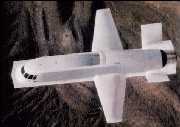

The TR3A Black Manta or Baby B-2 is widely
thought to be the successor to the Stealth Fighter. Sightings
around Area 51 are starting to be made of a smooth, rounded flying
wing that is much smaller than a Stealth Bomber. Faster and more
stealthy than the F-117, some believe it has already seen combat.
It supposedly works in tandem with the Stealth Fighter, relaying
target information.
|
|
|
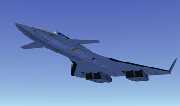
The Brilliant Buzzard or Mothership is thought
to be a huge aircraft with a wingspan of two hundred feet or so
which actually launches smaller reconnaissance craft. Sightings of
this delta winged craft first began in the early nineties. Some
believe that it and the Aurora are one and the same.
|
|
|
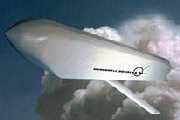
The newest cruise missiles all sport stealth
technology to overcome their relatively low speed. Early stealth cruise missiles
were tested at Area 51 but no version is currently in service. The more "white"
versions from Lockheed are pictured here.
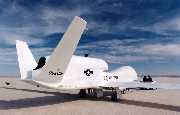
Most of Area 51's current testing involves UAVs
or unmanned aerial vehicles. While currently designed for
reconnaissance, UAVs will be later designed for remote control
combat. Since they are unmanned, it is widely believed that some
can move and turn at extreme speeds. In a sense, true man made
UFOs. The more "white" versions are pictured here.
|
|
|
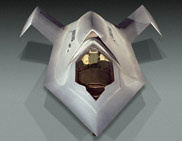
Named after the Klingon Bird of Prey from Star
Trek, this fighter or tactical bomber prototype was just unveiled
on October 18, 2002. Built at Boeing's Phantom Works as a proof of
concept, this craft is thought to be able to attain speeds of 300
mph. It was first flown in 1996 and uses new technologies that
enable it to fly stealthy even during daylight.
|
|
|

While not fully an Area 51 only project,
pop-ups like the X-33 and others are thought to have technology
that was pioneered at Area 51. They often sport "new" technology
that is already developed but yet has never been tested on known
aircraft. In fact, some believe that the X-33 space plane is
really the "white" version of the Aurora.
|
|
|
MORE
VIEWS OF THESE PLANES
Top secret stealth jet revealed
NOTE: This is NOT the aircraft I saw.
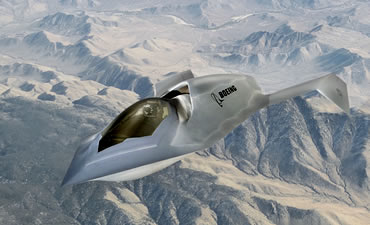
The Bird of Prey has a wing span of 7.0 metres and a
length of
14.3 m (Image: Boeing)
- 15:19 21 October 2002
- NewScientist.com news service
- David Windle
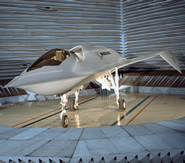
The aircraft has been revealed but the stealth technologies
remain secret (Image: Boeing)
A formerly top secret, bat-winged stealth jet has taken the
aviation world by surprise, after a low key unveiling in St Louis,
Missouri.
It may look like it flew straight off the screen of a sci-fi
movie, but the Bird of Prey is no flight of fancy - it could
translate into serious business for its makers, aerospace giant
Boeing.
"Here we have an example of a classic 'black' programme: an
aircraft which has been built and flight tested for a number of
years - and no one outside the programme knew about it," says Nick
Cook, aerospace consultant to Janes Defence Weekly. Other
highly classified aircraft that have ultimately been revealed
included the U-2 and Blackbird spy planes and the B-2 stealth
bomber.
The Bird of Prey cost $67 million and is the product of Boeing's
advanced research and development division, the Phantom Works. It
first flew in 1996 and is said to have demonstrated a range of
stealth and production technologies.
Agile and stealthy
It is a single seat, single engine design and with a reported
maximum altitude of 6100 metres (20,000 feet). Its top speed is a
relatively sedate 480 km/h (300 mph).
The unconventional configuration of the Bird of Prey suggests it
has been designed to be highly agile and stealthy. But even though
the aircraft itself has been revealed to the public, the stealth
systems designed to suppress acoustic, infra-red, radar and even
visual signatures are likely to be as highly classified as ever.
Sources suggest they may include active camouflage systems to
reduce visibility by using panels or coatings that change colour or
luminosity. This could allow safe combat missions in daylight,
rather than being restricted to night flying. "And that would
represent a revolutionary milestone in aerial warfare," says Cook.
It is known that such technologies have been studied for several
years, most probably at the remote test site in the Nevada desert
near Groom Lake, better known as Area 51. This was also the probable
location for the Bird of Prey's 38 test flights.
You can view video of the Bird of Prey in flight
here (.mov, 13Mb) or
here (.mpg, 50Mb) (hosted by Boeing)
A key aspect of the project was that the aircraft would be
inexpensive to build. Phantom Works engineers say they used
disposable tooling and 3-D virtual reality for its design and
assembly.
It has not been confirmed whether the Bird of Prey was ultimately
intended to be manned or unmanned. But the aircraft has clearly had
a major influence in the design of Boeing's unmanned combat air
vehicle (UCAV) demonstrator, the X-45. Two of these pilotless combat
planes are currently undergoing test flights.
Armed UCAVs are among the hottest projects in military aviation,
having the obvious advantage of not risking life, as well as being
cheaper than manned aircraft.
Cook is not surprised that the Bird of Prey was at least
initially a manned aircraft, as this helps gather performance data.
"You may be sure that lessons learned from this programme will find
their way into both manned and unmanned aircraft, not simply in
terms of flight characteristics, but crucially in the method of
design and production," he says. And any company that steals a lead
on its UCAV competitors stands to win very lucrative development and
production contracts in the future.
B-2 Stealth bomber as antigravity craft
by Richard Boylan, Ph.D.
Date: 09/20/97
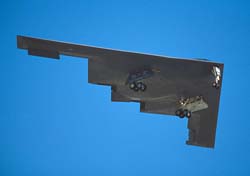
Retired Air Force Colonel Donald Ware has passed on to me information from
a three-star general he knows who revealed to him in July that "the new
Lockheed-Martin space shuttle [National Space Plane] and the B-2 [Stealth
bomber] both have electro-gravitic systems on board;" and that " this explains
why our 21 Northrop B-2s cost about a billion dollars each." Thus, after taking
off conventionally, the B-2 can switch to antigravity mode, and, I have
heard, fly around the world without refueling.
Thus, the B-2 Spirit advanced bomber has hybrid propulsion and lift
technologies, utilizing jet thrust for public take-offs and landings, to look
conventional, but switching to antigravity mode for extended cruising range, for
lightning-fast maneuverability, and for shrouding the airframe in invisibility
(by having its local anti-gravity field bend space-time, and thus light, around
the airframe). This "disappearance" from conventional 3-D space-time provides
the B-2 with virtually undetectable infrared, acoustic, electromagnetic, visual
and radar signatures."
The unstable lift and forward-motion characteristics of the B-2's boomerang-like
airframe are merely temporary, until it moves into antigravity mode, where
independent field propulsion provides stability.
Further commentary, revealing that the government eventually plans to
release antigravity technology publicly, is provided by Colonel Ware.
He says, "Apparently this highly-controlled military program was used to gain
experience with 4th-density technology that may transform civil
aviation, after all national leaders choose peace."
The Colonel thus is suggesting that the Black Projects units behind this
antigravity craft are going to share their technology with everyone, once North
Korea's Kim Jong-il and Iranian President Ahmadinejad settle down.
But the Cabal organization hoarding antigravity technology actually will share
antigravity technology only when pigs fly. And the pigs will have to do so
without the highly-classified electrogravitic technological asssistance.
Richard Boylan, Ph.D.
Dr. Richard Boylan is a behavioral scientist, university instructor,
certified
clinical hypnotherapist, and researcher into extraterrestrial-human encounters.
Richard Boylan, Ph.D., LLC, Post Office Box 22310, Sacramento,
California 95822, United States of America. Phone: (916) 422-7400 (PDT)
E-mail: drboylan@sbcglobal.net WEBSITE: http://www.drboylan.com
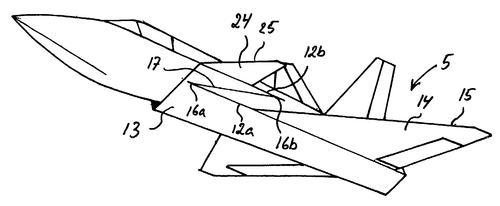
| Publication Number: |
|
WO/2003/098739 |
|
International Application No.: |
|
PCT/SE2003/000705 |
| Publication Date: |
27.11.2003 |
International Filing Date: |
30.04.2003 |
|
| Int. Class.: |
B64C
1/00 (2006.01), F41H 3/00 (2006.01) |
| Applicants: |
SAAB AB [SE/SE]; S-581 88 Linköping (SE) (All Except
US).
BJERKEMO, Jakob [SE/SE]; Havregatan 11 A, S-582 53
Linköping (SE) (US Only). |
| Inventor: |
BJERKEMO, Jakob [SE/SE]; Havregatan 11 A, S-582 53
Linköping (SE). |
| Agent: |
OLSSON, Jan; Bjerkéns Patentbyrå KB, Box 1274, S-801 37
Gävle (SE). |
| Priority Data: |
|
Air Combat Command's only F-117A unit, the 4450th Tactical Group,
achieved operational capability in October 1983. Since the F-117’s first
Air Force flight in 1982, the aircraft has flown under different unit
designations, including the 4450th Tactical Group and the 37th Tactical
Fighter Wing at Tonapah Test Range, NV; the 57th Fighter Weapons Wing,
Nellis AFB, NV; the 410th Flight Test Squadron/410th Test Squadron,
Palmdale, CA; and Detachment 1, Test Evaluation Group, also at Holloman,
which falls under the 53rd Wing, Eglin AFB, FL.
The stealth fighter emerged from the classified world while
stationed at Tonapah Airfield with an announcement by the Pentagon in
November 1988 and was first shown publicly at Nellis in April 1990. The
4450th TG was deactivated in October 1989, and was reactivated as the
37th Tactical Fighter Wing.
In 1992 the F-117A Nighthawk made its new home at Holloman Air
Force Base. The official arrival ceremony for the F-117 to Holloman AFB
was conducted 09 May 1992. The 49th Fighter Wing (49FW) at Holloman
serves as the only F-117 Home Station. The 49th Operations Group
operates and maintains the F-117A aircraft. The 7th CTS "Screamin'
Demons" serves as the transition
training unit, preparing experienced Air Force pilots for
assignment to the F-117A Nighthawk. The 8th and 9th Fighter Squadrons
are designated to employ the F-117A Nighthawk in combat. Once an F-117
pilot has successfully completed training, he is then assigned to one of
only two operational Nighthawk squadrons--the 8th FS "Black Sheep" and
the 9th FS "Flying Knights." The 49FW provides full compliment of
flightline maintenance capabilities as well as back-shop support. The
F-117 deploys in support of contingency operations, as directed by
National Command Authorities. Flightline maintenance support is deployed
concurrent with the aircraft. Depending on the deployment duration,
varying levels of back shop maintenance support may also be deployed.
The F-117A first saw action in December 1989 during Operation Just
Cause in Panama. On 20 December 1989 pilots of the two F-117As flew to
Rio Hato, Panama, to drop one 2,000-pound bomb each within 150 yards of
the PDF’s 6th and 7th Rifle Company barracks to stun and confuse the
occupants just before Rangers of Task Force RED parachuted into the
area. Upon reaching the target area, the pilots encountered high winds
coming from an unanticipated direction. The lead pilot swung to the
left, and dropped his payload only sixty yards away from the barracks
that was supposed to be the near target of the pilot in the second
aircraft. Keying on the first pilot, the second pilot dropped his bomb
further to the left, up to three hundred yards away from the target that
had been originally assigned to the lead pilot. Despite the error, the
bombs exploded precisely where aimed and momentarily stunned the PDF
troops occupying the barracks.
The stealth fighter attacked the most heavily fortified targets
during Desert Storm (January-February 1991), and it was the only
coalition jet allowed to strike targets inside Baghdad's city limits.
The F-117A, which normally packs a payload of two 2,000-pound GBU-27
laser-guided bombs, destroyed and crippled Iraqi electrical power
stations, military headquarters, communications sites, air defense
operation centers, airfields, ammo bunkers, and chemical, biological and
nuclear weapons plants.
Although only 36 stealth fighters were deployed in Desert Storm
and accounted for 2.5 percent of the total force of 1,900 fighters and
bombers, they flew more than a third of the bombing runs on the first
day of the war. In all during Desert Storm, the stealth fighter
conducted more than 1,250 sorties, dropped more than 2,000 tons of
bombs, and flew more than 6,900 hours. More than 3,000 antiaircraft guns
and 60 surface-to-air missile batteries protected the city, but despite
this seemingly impenetrable shield, the Nighthawks owned the skies over
the city and, for that matter, the country. The stealth fighter, which
is coated with a secret, radar-absorbent material, operated over Iraq
and Kuwait with impunity, and was unscathed by enemy guns.
In response to a real world crisis, the wing’s F-117s began a
deployment to Kuwait in November 1998, reaching an intermediate point in
Europe before being turned around and sent back to Holloman.
In the opening phase of Allied Force, aimed primarily at
Yugoslavia's integrated air defense system, NATO air forces conducted
more than 400 sorties. During the first two night attacks, allied troops
in the air and at sea struck 90 targets throughout Yugoslavia and in
Kosovo. F-117 Nighthawks from the 8th Expeditionary Fighter Squadron at
Holloman Air Force Base NM participated in air strikes against targets
in the Balkans during NATO operations. The wing deployed 25 F-117A
Nighthawks and more than 550 people to Aviano Air Base, Italy, and
Spangdahlem Air Base, Germany, in support of the air operation. F-117s
flew combat missions against the most highly defended, high value
targets throughout the 78-day air campaign, including first-night
attacks.
One F-117 fighter was lost over Yugoslavia on 27 March 1999. A US
search and rescue team picked up the pilot several hours after the F-117
went down outside Belgrade.
An Air Force F-117A Nighthawk from the 49th Fighter Wing, Holloman
AFB, N.M., crashed 7 miles south of Zuni, New Mexico, 10 May 1995. The
pilot, Capt. Kenneth W. Levens, 9th Fighter Squadron, was killed in the
crash. The stealth was on a training mission when the accident occurred.
The F-117A had an excellent year during FY96. There were no Class
A's, only one Class B, and four Class C mishaps. This is an impressive
record. The Class B resulted from a failed power takeoff (PTO) shaft.
The pilot did an excellent job of determining the proper emergency
procedures to follow and recovered a valuable national resource. The
Class C mishaps involved a misrouted cross-bleed detector loop, failed
oil pressure transducer, damage to a UHF antenna which occurred during
air refueling, and failure of the right main landing gear upper scissor
link.
From a historical perspective, by the end of 1996 there had been
three Class A and three Class B mishaps in the F-117 world. This total
included only those mishaps since the aircraft officially came into the
Air Force inventory. The Class A's include a bleed air leak which
eventually caused the pilot to eject, an engine fire due to an engine
manifold leak, and failure to recover from an unusual attitude. The
Class B's include a brake failure on landing roll which caused damage
upon barrier engagement, a lost canopy during flight, and the failed PTO
shaft.
Air Combat Command’s 1996 Senior Noncommissioned Officer of the
Year was Master Sgt. Richard Acevedo. An 18-year veteran, Acevedo was
the resource advisor for the 49th Maintenance Squadron, Holloman AFB,
NM. Acevedo contributed to a 60 percent increase in the F-117A mission
capable rate over the previous two years and reduced F-117A flight
control computer testing and repair cycle time from 40 to three hours.
He also managed the squadron’s 517 Government
American Express accounts and funds for 44 temporary duty
assignments. His efforts with the Aerospace Guidance and Metrology
Center provided advanced training to Holloman members on Inertial
Navigation System (INS) test station maintenance, saving the wing
$123,300. He personally supervised dual-intensity modification on 26
F-117A display indicators with new checkout procedures, completing
critical mission-essential time-change directives two months ahead of
schedule.
In an effort to improve the combat effectiveness of the stealth
fighter, test experts from the F-117 Combined Test Force at Air Force
Plant 42 in Palmdale, Calif., are working to expand what it brings to
the fight. On April 2 2002, developmental test experts in Palmdale
teamed up with their operational counterparts from Holloman Air Force
Base, N.M., to complete the second phase of a demonstration project
designed to provide the F-117 and its pilots with the ability to receive
and transmit mission and target data in real-time from the air. Phase
one tests, completed in October of 1998, allowed a pilot to receive
live-threat information and manually replan a mission from the cockpit.
The second phase completed the test cycle by demonstrating the
transmission of real-time mission and target data out of the cockpit and
into the hands of command and control forces on the ground.
Until this testing, the potential time-critical combat
capabilities of the F-117 had not been explored. The target data
technology works by allowing the aircraft to receive and transmit
tactical information on targets or pop-up threats via satellite
communication. The fighter's ability to send and receive text and images
enhances its combat flexibility yet does not compromise its stealth
configuration.
The fleet of F-117As has been refurbished, including removing the
aging thin films and coatings and replacing them with a special
radar-absorbent paint that is easier and less expensive to apply and
maintain. During manufacture, the thin films and coatings of
radar-absorbent materials were painstakingly applied to each F-117A to
ensure that no defects existed. Any slight deviation from the
Nighthawk's exacting surface specifications -- even an air bubble or a
screw not tightened exactly to specifications -- could result in a blip
on an enemy's radar screen. The new painting process is no less
exacting.
Nighthawks are large aircraft -- 65 feet long with a 43-foot wing
span -- and each F-117A is slightly different from the others. The
Nighthawk's angularity and the need to keep the paint spray nozzles at
exactingly precise distances from the aircraft's surface at all times
require both accuracy and adaptability to adjust for variabilities from
one aircraft to another. Maintenance downtime for the F-117As needs to
be minimized so that each fighter is available for military operations
as soon as possible.
The first Nighthawk to be refurbished with the new coating was
done manually by five painters and a masking crew, and took 4 and a half
days. A Sandia National Laboratories development team created the system
concept, identified the needed hardware, wrote the custom
software that operates the system, and integrated the system's
commercial and noncommercial components as part of a 3-year development
project.
The first challenge in designing the automated painting system was
to find a robot or robots big enough to reach all of the plane's
surfaces. To keep costs down, the design team used commercially
available equipment as much as possible. The Sandia painting system
features three commercial robotic arms used in U.S. auto factories
called the Motoman P8. Two of the arms are mounted on 30-foot-long
rails. Each 10,000-lb robot-and-rail system is mounted on a specially
designed air lift so that two people can move its base to desired
locations around the aircraft. A paint nozzle at the end of each of the
robotic arms is connected via tubes and wiring to an oversized stainless
steel paint can. The coating-delivery system -- the paint nozzles,
tubes, pumps, and cans -- is also a Sandia creation. One robot-rail
combo paints the Nighthawk's top surfaces; the second paints the bottom
surfaces. Cameras and other sensors help a nearby computer plan and
guide the robots' every move. This merging of commercial hardware with
Sandia-designed custom hardware and software exemplifies Sandia's unique
system integration capabilities. The third floor-mounted, stationary
robot is for painting the Nighthawk's removable parts, such as weapon
bay doors and rudders.
The Sandia team developed a unique feedback, path-planning system
that adjusts for variabilities from aircraft to aircraft. Path planning
is the fruit of Sandia's years of research in "geometric reasoning,"
which was developed using DOE Defense Programs and Lab-Directed research
funding. Geometric reasoning gives robots the capability to
automatically determine the movements needed to carry out the task, even
if the workpiece varies from piece to piece, as do the F-117As. A pair
of stereovision cameras mounted at the end of the robotic arms locate
"landmarks" on an F-117A corresponding to vertices where a Nighthawk's
angular facets meet. Based on this feedback about the unique geometry of
each plane and information about the robot's reach, joint limits,
characteristics of the painting process and other factors, the software
automatically generates a path for the robot to follow as it paints. The
system also ensures that the robotic arms don't violate a 6-inch buffer
zone around the fighter. The motion-planning software is what allows
Sandia to rapidly and inexpensively develop robot systems for small-lot
production operations like painting a limited number of aircraft.
To design the system, Sandia used a 3-D computer model of the
F-117A provided by Lockheed Martin. Models permit the team to use
Sandia's geometric reasoning software to perform a "reachability
analysis" of the F-117A, which helped determine where the system's two
robot-and-rail systems would have to be repositioned on the hangar floor
to reach the entire aircraft.
Before painting begins and each time a robot-and-rail system is
moved during painting, the computer vision system automatically
registers reference points corresponding to three jack stands the
Nighthawk is placed on inside the hangar. It then measures the precise
locations of the two robot-and-rail systems with respect to the
aircraft. With almost human-like agility, the rail-mounted robotic arms
move with seven degrees of freedom. Six of those are the three spatial
dimensions (x, y, and z) plus roll, pitch, and yaw, which is normal for
many manufacturing-type robots. The seventh degree of freedom gives the
robot the ability to maintain a fixed x, y, z, roll, pitch, and yaw
position from multiple poses. This is like having an "extra elbow" to
reach around things that are in the way. It also gives a large range of
motion along the 30-foot rail required to coat a large aircraft.
The system was delivered to Lockheed Martin's Advanced Development
Projects group, better known as the "Skunk Works," in September 1998.
Members of the Sandia team helped install and acceptance-test the system
during the following five months. Safety precautions are incorporated
into the system and personnel are trained in robot awareness. In terms
of size and level of complexity, this was the largest intelligent system
Sandia has ever delivered to an outside customer.
Whereas the first aircraft was refurbished using five painters and
a masking crew taking four and a half days, the first robotically
painted aircraft at the Skunk Works took only three days with a smaller
crew. Once it is in a production mode, the system will provide
considerable cost and time savings to the Air Force. The new system also
improved the final finish quality and reduce maintenance costs by
minimizing the amount of time spent painting and reworking each
aircraft. Signature testing was performed on the robot-sprayed aircraft
and the results were significantly better than expected.
The Air Force, on 30 September 1998, awarded Lockheed Martin Skunk
Works (LMSW) a sole source, Total System Performance Responsibility (TSPR)
depot-level acquisition and sustainment weapon system support contract
for the F-117 Stealth Fighter that provides stable logistics support
into the next decade. This contract, beginning 1 October 98, continues
the logistics support necessary to fulfill the weapon system mission,
ensure combat capability and provide services presently performed by
LMSW, breakout contractors and the System Program Office (SPO). This
contract includes all support functions with the exception of
Intermediate and Organizational maintenance.
The original concept for F-117 was for a Contractor Logistics
Supported weapons system with a small SPO to oversee necessary
government functions. Accomplishment of Program Management
Responsibility Transfer (PMRT), in October 1989, moved the SPO from
Wright-Patterson to the Sacramento Air Logistics command (SM-ALC). The
ALC began the process of breaking out subcontractors and increasing
technical oversight, generating considerable duplication of effort. All
hardware, item management and distribution functions transferred to
Sacramento creating a "third leg" in the weapon system support pipeline.
SPO size ultimately increased to 226 providing sustaining management and
contractor oversight.
LMSW presently provides 75% of the core sustaining for the F-117.
All technical support is conducted under the annual sustaining contract
and individual upgrade programs. LMSW also operates the
modification/depot line at Site 7, AF Plant 42. These core capabilities
provide a solid foundation for effectively increasing the LMSW Program
Management role. TSPR expands LMSW responsibilities in the areas of
system engineering, material management, subcontractor management,
system & subsystem support, direct support to the user and AF reporting
requirements. The majority of tasks scheduled to transition from the SPO
are items already performed at LMSW. Government responsibilities will
continue to include program direction, requirement determination,
contract management, business/financial execution, product/service
acceptance and security. The SPO size is targeted to reach 55
people by the end of FY99 with a goal of 20 by FY01 as LMSW demonstrates
support capability. The TSPR contract will return the F-117 to the
original concept -- Contractor Logistics Support with LMSW as the prime
system integrator and a small SPO providing oversight capacity.
F-117 TSPR offers an incentive package to assure performance while
encouraging the contractor to reduce costs. The contract will have a 3%
Award Fee provision for subjective evaluation of technical, management,
subcontracting and customer satisfaction. Grading is based on input from
all aspects of the government including the SPO, ACC, the 49th Fighter
Wing (FW) at Holloman AFB, DLA and DCMC. A 7% Incentive Fee provision
based on seven performance metrics will track Non-Mission Capable
Supply, MICAP rates, Readiness Spares Provisioning (RSP) Kit fill rates,
Depot Quality, Depot Delivery, Delinquent Deficiency Reports and Weapons
System Trainer Availability. All items are currently tracked by the 49th
FW and SPO and are considered the most important indicators of program
support. Finally, TSPR provides for 50/50 cost share between the
government and LMSW on any under run with no ceiling. A minimum
performance of 50% on metrics is necessary to receive any additional
fee. Overruns are also shared 50/50 to the maximum of the Award and
Incentive fees combined.
F-117 TSPR has been identified as a pilot program for the Air
Force and DoD. This small fleet of 52 aircraft, located at a single
operating location at Holloman AFB, offers a unique opportunity for the
Air Force and LMSW to continue the F-117’s excellent program health.
Timing for this transition is optimum due to the BRAC decision to close
McClellan AFB, current location of the F-117 SPO. LMSW, as system
integrator, will compensate for anticipated SPO program experience loss
and complement a significantly downsized SPO with resident expertise.
TSPR represents a departure from "business as usual" as it allows LMSW
the flexibility required to manage sustaining funds, as appropriate,
over the eight years of the contract with no degradation of the total
program support posture. The contract makes LMSW accountable for
complete weapons system support. TSPR challenges the company to provide
support to the 49th FW that is "equal to or better than" current levels
while reducing Total Ownership Cost to the US Air Force.
The F-117 program is the Air Force’s most complete application of
Acquisition Reform initiatives and is successfully being operated with
reduced government oversight. The program was implemented with a
significantly reduced Air Force support capitol investment. The
commitment of the Air Force to a long-term supplier relationship has
allowed for optimal contractor investment.
A member of the 49th Fighter Wing made aviation history 02
November 1995 when he became the first operational Air Force pilot to
log 1,000 hours in the F-117A Nighthawk. Lt. Col. Greg Feest, 9th
Fighter Squadron commander, is a senior pilot with 3,350 total hours in
the F-117, F-15, A-7 and AT-38, including 130 combat flying hours in the
F-117.
On 21 November 1997, Major Ward Juedeman (Bandit 11) was returning
to base from an F-117A day surface attack tactics training mission with
approximately 15 minutes of fuel remaining. Maj Juedeman reported
initial and set up for his base turn. After lowering the gear handle,
Maj Juedeman noted that he only had a nose and right main gear down and
locked indication with a red light in the handle. He quickly tested the
lights, which checked good, and proceeded to break out of the overhead
pattern leaving the gear down. Maj Juedeman declared an emergency,
switched to the single frequency approach, and requested a safety chase.
Since no other aircraft were airborne, the supervisor of flying
immediately launched a T-38A that was taxiing for takeoff. After
rejoining with the safety chase, Maj Juedeman was informed that the nose
and right main gear were indeed down and locked with the left main gear
up and the gear door closed. Referencing the checklist, Maj Juedeman
attempted to raise the landing gear, but neither gear moved, leaving the
aircraft in a configuration which recommends ejection. Maj Juedeman put
the gear handle back down with no effect, and then attempted to lower
the gear using the landing gear emergency extension system. After
approximately 5 seconds the left main gear unlocked, deployed by gravity
and air loads, and appeared to lock into place. Maj Juedeman then flew a
flawless straight-in approach and landing.
An Air Force F-117A Nighthawk crashed 14 September 1997 while
performing a fly-by demonstration for an airshow at Martin State
Airport, 12 miles northeast of Baltimore. The pilot, Maj. Bryan Knight,
safely ejected. He suffered minor injuries. Four people on the ground
were injured and 10 families displaced by the crash, which caused
extensive fire damage to several homes and vehicles. There were no
fatalities or serious injuries. The aircraft had just completed its
third pass of an air show flyover at Martin State Airport near
Baltimore. The pilot was initiating his climb out for departure when he
felt the aircraft shudder and the left wing broke off. The accident
investigation report concluded that the cause of the accident was
structural failure of a support assembly, known as the Brooklyn Bridge,
in the left wing due to four missing fasteners of the 39 in the
assembly. The Brooklyn Bridge assembly was apparently improperly
reinstalled during a scheduled periodic inspection in Jan. 1996. The
entire fleet of 53 F-117 Nighthawks was inspected during a
command-directed precautionary stand down and none were found to have
the same defect.
The F-117 stealth fighter completed flying its 150,000 flying hour
when Brig. Gen. Bill Lake, 49th Fighter Wing commander, touched down on
Holloman's runway 25 August 1998. The flying milestone was measured from
the first F-117 flight by Lockheed Martin test pilot Hal Farley on June
18, 1981. The first Air Force pilot to fly the F-117 was then Maj. Al
Whitley on Oct. 15, 1982.
The F-117A program has demonstrated that a stealth aircraft can be
designed for reliability and maintainability. The aircraft maintenance
statistics are comparable to other tactical fighters of similar
complexity. Logistically supported by Sacramento Air Logistics Center,
McClellan AFB, Calif., the F-117A is kept at the forefront of technology
through a planned weapon system improvement program located at USAF
Plant 42 at Palmdale, Calif. The F-117A Combined Test Force is a diverse
organization that includes military members, government civilians and
various contractors who work together to test the latest F-117
improvements. The test force works out of U.S. Air Force Plant 42 in
Palmdale, Calif, just south of Edwards. As a reflection of the Nighthawk
itself, the F-117A Combined Test Force maintained a stealthy profile
when it first began testing the revolutionary plane.
A recent CTF project involved testing an improved navigation
system for the F-117A. Now operational, that system is a prerequisite on
all deployed F-117As. The Lockheed Martin Skunk Works delivered the
first F-117A configured with a new navigation system to the 49th Fighter
Wing in January 1997. Dubbed "RNIP-Plus," the Ring Laser Gyro/Global
Positioning System Navigation Improvement Program reduces the drift
pilots experience during flight. Drift is when an aircraft's navigation
system wanders off its intended flight path -- a computer problem in the
older Inertial Navigation Systems. Not only does the RNIP-Plus boost
navigation, it also strengthens the F-117A's targeting capability. The
configuration includes a new control display navigation unit in the
cockpit allowing the pilot to quickly reference and check flight data.
The control display also collects and stores maintenance data on the INS
and GPS, a plus for post-mission maintenance.
In another recent project, F-117A experts tested a real-time
information into the cockpit capability for the Nighthawk that will now
allow real-time communication with the outside world while the plane is
in stealth mode. This capability includes integration of a new real-time
symmetric multi-processor, which allows onboard mission planning at
faster computation times than current ground mission planning. If this
new technology is put into the aircraft, the pilot will have the ability
to adjust his mission based on changing threats and targets, a
capability previously unavailable.
The Advanced Composites Program Office (ACO) at Hill AFB led an
in-house effort to reduce cost of ownership of F-117A composite
structures. As a high-usage trailing-edge component, the 20D82 is
required to endure high temperatures from the engine exhaust. Problems
with this component included short service-life, high cost, poor fit,
large part-to-part variances, and lack of repair procedures. The latter
forced the Air Force to replace the component at a cost of $46,400 per
item until effective field and depot level repair procedures were
developed by the ACO, working with the F-117A System Program Manager
(SPM) and SM-ALC/TIM composite manufacturing personnel. Each component
repair costs approximately $4,200. After providing a repair, the team
set out to totally redesign the troublesome component. They were able to
simplify the design, increase service temperature capability, maintain
low observable requirements, and reduce the assembly part count from
fifteen to six. The cost of the redesigned component is half of the
original cost for twice the capability.
The Single Configuration Fleet (SCF) program is intended to reduce
the total ownership costs of the F-117 by standardizing the fleet to a
single optimized spray/sheet coating and edge configuration. The Single
Configuration Fleet modification consolidates the existing seven
different F-117 radar-absorbing material configurations into one
optimized for maintainability and deployability. This will reduce LO
maintenance requirements and take advantage of state-of-the-art robotic
technology. The F-117's low-observable features have always been costly
and difficult to maintain because of the various radar-absorbing
material configurations. To correct this, the Single Configuration Fleet
modification consolidates the existing seven different radar-absorbing
material configurations into one optimized for maintainability and
deployability.
The modification, entailing stripping and re-coating the entire
F-117 fleet, replaces the sheet-coated RAM on the wings, rudders and
fuselage and uses a precise robotic process to apply a RAM coating to
almost 75 percent of the airframe, he said. These areas which are never
accessed for maintenance will require virtually no future RAM repairs.
Areas that are frequently accessed will have removable RAM sheets
applied to the maintenance panels. The new spray-coated RAM is much more
durable than previous versions of sheet-coating. This will result in the
new (Single Configuration Fleet) aircraft requiring fewer RAM repairs.
The optimized configuration provides maintainers easy access to
maintenance panels while eliminating the need to repair infrequently
accessed areas.
The biggest advantages of the new standardized configuration, for
maintainers and the Air Force, will be common repair procedures and
materials for all F-117s. Currently, with so many configurations, there
are numerous repair procedures and materials. Maintainers must keep
track of which procedures and materials belong to which aircraft.
Maintaining the aircraft will be much easier once the entire fleet
undergoes its modification. The Air Force should also see a 50 percent
reduction in the size of our technical order -- the manual airmen must
follow step-by-step when working on aircraft maintenance.
The new modification also will greatly reduce the amount of
hardware and other supplies that units will need when they deploy to
forward locations. The Air Force will be able to phase out a number of
materials leading to further cost savings in the logistics and materiel
management. Based on flight test results and an initial operational
evaluation, the new SCF configuration will reduce maintenance manhours
per flying hour due to (RAM) maintenance by over 50 percent. Since low
observability is the primary maintenance driver for the F-117, the SCF
improvements will indirectly improve sortie generation capability.
Additionally, once SCF is implemented in the entire F-117 fleet, the
annual consumable material costs will be reduced from the current level
of $14.5 million to approximately $6.9 million.
The modification is being implemented on a five-year schedule as
the F-117s are rotated through the contractor depot at Palmdale, CA. To
make best use of this time, the Air Force is also implementing numerous
other F-117 modifications and repairs. The entire process takes
approximately five months for each aircraft. The first completed
production aircraft to undergo the modification was delivered to
Holloman in April 2000. Holloman is the only base in the Air Force that
flies the F-117.
With a goal to obtain MK-84 and BLU-109 Joint Direct Attack
Munitions weapons certification for the F-117A Nighthawk aircraft, the
Seek Eagle Office at Eglin AFB, Fla., sponsored a weapons separation
test in AEDC's 4-foot transonic aerodynamic wind tunnel. Additional test
customers included Lockheed Martin Skunk Works, manufacturer of the
F-117A, and Boeing, St. Louis, manufacturer of the JDAM weapons system.
Lockheed-Martin Aero modifies nine F-117 aircraft per year at its
Palmdale facility. The Air Force thinking is that it will phase out the
Nighthawks after 2018.
